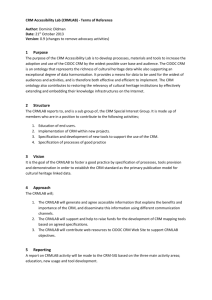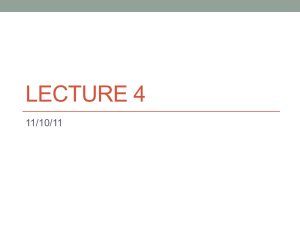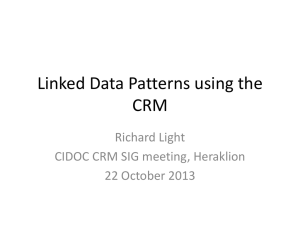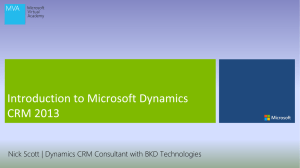3rd CHIOS/CIDOC CRM Special Interest Group
advertisement
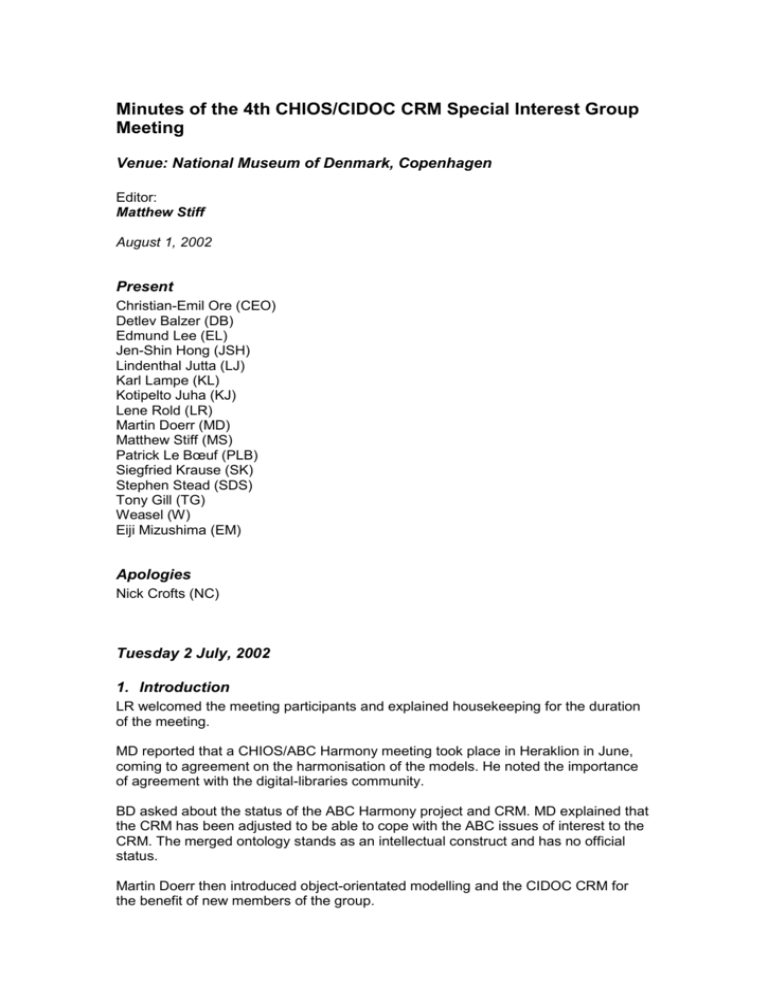
Minutes of the 4th CHIOS/CIDOC CRM Special Interest Group Meeting Venue: National Museum of Denmark, Copenhagen Editor: Matthew Stiff August 1, 2002 Present Christian-Emil Ore (CEO) Detlev Balzer (DB) Edmund Lee (EL) Jen-Shin Hong (JSH) Lindenthal Jutta (LJ) Karl Lampe (KL) Kotipelto Juha (KJ) Lene Rold (LR) Martin Doerr (MD) Matthew Stiff (MS) Patrick Le Bœuf (PLB) Siegfried Krause (SK) Stephen Stead (SDS) Tony Gill (TG) Weasel (W) Eiji Mizushima (EM) Apologies Nick Crofts (NC) Tuesday 2 July, 2002 1. Introduction LR welcomed the meeting participants and explained housekeeping for the duration of the meeting. MD reported that a CHIOS/ABC Harmony meeting took place in Heraklion in June, coming to agreement on the harmonisation of the models. He noted the importance of agreement with the digital-libraries community. BD asked about the status of the ABC Harmony project and CRM. MD explained that the CRM has been adjusted to be able to cope with the ABC issues of interest to the CRM. The merged ontology stands as an intellectual construct and has no official status. Martin Doerr then introduced object-orientated modelling and the CIDOC CRM for the benefit of new members of the group. The CRM now has an ISO draft number: ISO 21127. The group broke for lunch at 12:00 The group reconvened at 13:30. Note on version control: Version 3.2 is the one submitted to ISO.Version 3.3 was produced following the Paris meeting. 3.3.1 was produced following the Monterey meeting. Version 3.3.2 exists in the SIS system at FORTH. Introducing RDF/RDFS & encoding the CRM in RDFS Martin Doerr introduced the origins of RDF. The proposals of the Warwick framework did not become a standard and we now have different encoding schemes. Proposal: Create an official name-space prefix for the CRM and a URI to point to it. Amendment session - Natural History issues 3, 76, 77 Issue 3: How to model life stages of natural history specimens. Decision: Proposal accepted. Issue 76: Contemporary naming procedure Decision: The more generic of the two proposals was accepted. Type becomes a subclass of Conceptual Object (E28), link 67 changes domain to Information Object (E73) Issue 77: Identification Procedure. Decision: Issue resolved by adding to scope note for E17 that determination is an example of Type assignment in the biological sciences. Issue closed New Issue: Physical Object exhibits general feature: Type should be included in the extended documentation. Amendment session - Physical Carrier issues 7 & 85 Issue 7: How to model relation between physical carrier and conceptual objects Decision: Resolved by creating new entity: Information Carrier to replace Iconographic Object (E23). The link for this would be “is carrier of (is materialised by)” which points to Information Object (E73). E23 is not a subclass of E73. Issue 85: Physical carriers and properties Decisions: 1: Change P62 into P62 depicts (is depicted by): E1 CRM Entity – Proposal accepted 2: Delete P63 & P64. Proposal accepted 3: Create a new link: E36 Visual Item “visualizes (has visualization)”: E1 CRM Entity, a sub-property of “P67 refers to”. Proposal accepted. Amendments – Issues 14, 86, 67, 21, Issue 14: How to model subjects. Proposal 1: The CIDOC CRM should model only the aboutness relationship. Should be covered by decision on P67 refers to (see Issue 86). Decision: Proposal rejected Proposal 2: Create new link E73 Information Object: is about (is subject of) E1 CRM Entity, sub-property of P67. Action: Write scope note for this Decision: Proposal accepted Issue 86: P66 refers to concept is redundant Decision: Proposal accepted. Issue 67: How to model the birth of living beings in general. Decision: The birth of living beings in general is sufficiently covered by the entity Begin of Existence. Proposal accepted Decision: create new extended document issue explaining how to deal with the birth of non-humans. Issue 21: How to model membership entity with temporal properties. Decision: Dealt with by solution to issue 23. Issue 23: Where does temporal validity fit in with short cuts and indirection? Decision: A guideline should be created describing a general extension mechanism compatible with the CRM, which provides temporal validity to any attribute. The attribute becomes a shortcut of the temporal entity describing the range of validity. Action: Create guideline Issue 56: Objects which are typical for a class. Decision: Issue covered by Issue 76: E55 Type is exemplified by (exemplifies) : Entity (in the taxonomic role: Type) Issue 61: Do we need a property “is copy of”? Decision: This relation is needed. Decision: Stuff: P132 shows feature of (features are also found on): Stuff (kind of similarity: Type) Proposal accepted. Issue 84: Consistency of P60 is member of and P107had member Decision: 1. Delete P60 as redundant. Proposal accepted. 2. P107 to be renamed: P107 has current or former member (is current or former member of). Proposal accepted. 3. P107 makes Persons the atomic elements of Groups. This is sufficient. Temporal validity of membership seems to be out of practical scope, if not otherwise. Accepted. The group broke 17:00. CHIOS partners remained for a CHIOS management meeting (see separate minutes). Wednesday 3 July, 2002 The group reconvened at 09:00. Present Christian-Emil Ore (CEO) Detlev Balzer (DB) Edmund Lee (EL) Jutta Lindenthal (JL) Karl Lampe (KL) Kotipelto Juha (KJ) Lene Rold (LR) Martin Doerr (MD) Matthew Stiff (MS) Patrick Le Bœuf (PLB) Siegfried Krause (SK) Tony Gill (TG) Eiji Mizushima (EM) CRM mapping utility MD introduced the CRM-XML mapping tool developed by Nick Crofts and refined by ICS-FORTH. An updated version of the tool will be posted on the CRM web site soon. EL asked if it could be made available in Access 97. MD agreed. Amendment Issues (continued) Issue 70: Relationship between P15 and P16. Decision: P15 Activity was influenced by (influenced) E1 Entity P17 Activity was motivated by (motivated) E1 Entity P19 Activity was intended use of (was made for) Man-made Stuff P16 Activity used specific object (was used for) Stuff P20 Activity had specific purpose (was purpose of) E7 Activity Pxx Activity continued (was continued for ) E7 Activity Delete P18 Activity was motivation of (motivated) E1 Entity because it is subsumed within P17. P16, P17, P19, P20 and Pxx are sub-properties of P15. Scope note comment (for Pxx): If one activity is continued by another it would be possible to regard both activities as part of a larger one. Action: MD to post information on process models to CRM SIG list Issue 96: use of software tools. Decision: Covered by Issue 70 Issue 79: Change property name P17 was motivation of to was motivated by Decision: Covered by Issue 70 Issue 80: Change range and name of P18 motivated the creation of Decision: P18 is deleted by Issue 70. Issue closed Issue 89: P85 consists of is redundant. Decision: Proposal accepted Issue 91: P72 has language is redundant Decision: A language has more complex relationship with a text. Keep link P72 and the type Language. Change scope note to E33 linguistic Object – replace “physical language” with “natural language”. Enrich scope note to include languages which are not documented in writing - see “Jabberwocky” by Lewis Carroll. Computer languages are to be excluded (to be kept as Information Objects). Action: TG to redraft scope note for E33 and post to list. Issue 44: Modelling states Decision: Situations should not be included in the CRM. Extension guidelines to be given within the CRM documentation for those dealing with Situations. Action: Create extension guidelines. Issue 69: Spatiotemporal overlaps of periods. Decision: Proposal agreed Issue 88: Rename property P81 at least covering and P82 at most within Decision: Proposal 2: Rename P81 to P81 ongoing throughout Rename P82 to P82 at some time within Proposal accepted. Issue 90: Scope notes of E52 Decision: Scope note to be rewritten as follows: A determination of a range of dates or duration without any further connotations, to be used to set limits to the temporal extent of periods, events and any other phenomena valid for a certain time. A time appellation is a verbal form that refers to a time-span. The time-span itself is a temporal extent in the sense of Galilean physics. Different time-appellations may express the same time-span. The Time-Span represents the real extent of the entity it refers to, which is always fuzzy to a certain degree and only known in approximation. Respective properties of Properties of timespan allow the expression of approximations of a time-span according to our knowledge. Issue 36: How to model sequences of physical and conceptual objects Decision: Proposal 2 accepted: Issue 52: Where does an instance of a multimedia object appear in the CRM? Decision: Proposal accepted (points 1 & 2) Action: TG to explicitly mention multimedia objects and reference Jane Hunter’s mpeg 7 paper in extension to scope note for Information Object (E73). Issue 62: Do we need an Actor appellation entity? Decision: Proposal 2 accepted: Actor Appellation to be added to the CRM. Distinctions between people and corporate bodies to be made by use of Type. Action: TG to write scope note for Exx Actor Appellation Issue 72: Scope note of Modification. Decision: New scope note to be written for E11 Modification Event: This entity comprises all activities that alter or change physical man-made objects. Examples of modification events include the creation of an item from raw materials, the restoration or conservation of an object, or the re-use of an ancient object in the creation of a new object. This entity can be collective; the printing of a thousand books, for example, would normally be considered a single event. Since the distinction between modification and creation is not always clear, modification is regarded as the more generally applicable concept. This implies that some items may be consumed or destroyed in a modification event, and that others may be created as a result of it. Typically, objects routinely involved in the modification event, such as tools or materials, are modelled as attributes of the Design or Procedure for efficient data representation. However, unusual and remarkable items or materials used for a specific instance of a modification event should be associated with the modification event. Issue 78: P16 took into account to become a sub-property of P12 (because of the outcome of Issue 70). Decision: Proposal not accepted. Influence does not imply the presence of influential physical objects. Issue 92: Declare all disjoint classes. Decision: Proposal 2 accepted: Only include 2 disjoint classes: Action: MD to edit the scope notes to identify the high level disjoints between Conceptual v Physical and Temporal v Existential Issue 93: Also represented by Decision: Proposal accepted Issue 82: Review the range for P24 transferred title of Decision: Proposal accepted Issue 83: P51 through to P55 should move from physical object to Physical Stuff Decision: P51, P52 and P53 change domain from E19 to E18. Issue 94: Position of Legal Object Decision: Put Legal Object under Stuff, which makes the fundamental facets much clearer. Proposal accepted. Check scope note for Legal Object to ensure that it is in agreement. Issue 95: P12 occurred in the presence of Decision: P12 occurred in the presence of (was present at) should have range E77 Persistent Item in order to include Actors and other things. Proposal accepted. P11 becomes a sub-property of P12 occurred in the presence of (was present at). Property scope notes The group then worked on the updating of the property scope notes (see Properties scope note document for details). SD joined the group after 16:00. The meeting adjourned at 18:30. Thursday 4 July, 2002. The group reconvened at 09:00 The day was devoted to the editing of property scope notes. These were recorded in the property scope note document. Accepted notes were coloured green. Additional notes were given to properties where further actions are required. Property scope notes Action: MD to write new scope note for E42. Decision: The property scope note document from the Copenhagen meeting will be the source of property names, scope notes, super classes and cardinality for properties. Action: MD to check axioms of parthood that apply to P46 Action: MD to replace all instances of the word “link” with “property” Proposal: Delete redundant property P77. This is addressed by P107. Action: P77- MS to check MODES Object Format for slavery (specific examples preferred). Action: MS to make proposal to rename P79 & P80 Action: MS to make proposal to rename P91 The group retired at 18:00 Friday 5 July MD discussed arrangements for the next meeting, 22 October, Crete. The meeting will last for 4 days, will deal with remaining property scope notes (proposals required before then. He would also like to invite CMS vendors to widen the audience for the model. The project will also need to make plans for the Spring meeting. A set of remaining issues must still be dealt with, dealing in particular with documentation. These are to be discussed in later in this meeting. The next meeting must also discuss how the maintenance of the model following ISO submission, what the interests of the group are etc. There is a big interest in application of the model, its refinement for specific applications and harmonisation with other standards. MD will try to get an invitation from the Institute of Mediterranean Studies, another institute at FORTH based at Rethymon. Revision of scope notes (continued) The remaining property scope notes (P1-P108) were discussed (see separate property scope notes document). Action: MS to make proposal to rename P96 & 97 Action: MD to revise scope note for E67 Birth to clarify situation with multiple offspring. MD asserted that a 1:1 link cardinality indicates a methodological error. Action: MD to check property scope notes to clarify triangular general type/specific type relationships (c.f. P103) Action: MD to make proposal to delete has note property on property for P105, which is a shortcut for P104 – P75 through Right. This should be a note on Right. Action: Nick Crofts to check mutual consistency between E30 Right and E72 Legal Object scope notes. Action: MS to propose draft scope notes for P109-P127. Presentations by Jen-Shin Hong and Eiji Mizushima JSH gave a presentation to the group on digital museum projects in Taiwan: Digital Museum Project, National Digital Archive Project and the National Cultural Database Project. Eiji Mizushima then gave a presentation on the trends towards standardisation in museum management and collections management in Japanese museums. MD suggested time be put by to discuss relevance issues. He also talked about what is meant by “quality” in a museum context. He mentioned work by Carl Lagoze on determining and recording authority behind information. (Carl Lagoze, “Business Unusual: How "event awareness" may breathe life into the catalog”, Bibliographic Control for the New Millennium, Library of Congress, November 2000.) Museums preserve things as material evidence, and the importance of the role of museums as a quality mark for information. Issues Issue 58: How to organise the translation of the model. MD explained that NC had argued that the translations should be carried out by particular teams or individuals. MD argued that the selection of the correct names for entities and properties requires interaction between a number of individuals to ensure that the concepts have been correctly expressed. SD suggested that the entity and property names should not be renamed, only the scope notes. SK pointed out that the properties and entities can already be identified by neutral numbers: the names themselves are required to give meaning. MD stated that the scope notes should be used to identify new names in languages. EL pointed out that the original English source should be used as source in order to prevent errors from translating translations. SDS suggested that before providing translation of names the scope notes should be translated. Decision: reformulated proposal: The CIDOC CRM SIG should ask for proposals for names for entities and properties in different languages in order to get lists of alternatives for the proposed translations. Decision accepted. Issue 87: Ownership and Legal Rights. Decision: Add to scope note: An E8 Acquisition Event implies establishment and/or loss of ownership rights on the implied physical objects or features. E8 does not, however, imply changes of rights in general Issue 46: Explanation about referring to use of materials in events and procedures. Decision: This will become an FAQ. Action: Create FAQ Issue 72: Scope note of modification Decision: Proposal agreed Issue 81: Numbering of properties Decision: Approved and implemented. Issue 90: Scope notes for E52. Decision: Approved and implemented Issue 16: Which terminology should we use? Action: TG & MD to go through the text of the document looking for inconsistencies. Particular words to look out for are class, entity, attribute, subclass, super-entity, link, property etc. Replace entity with class, for example. Proposals should be made on use of terminology. Action: TG, NC and MD to make proposals. A final decision to be made at the October Crete meeting. Decision: The CRM will not attempt to be compatible with ISO 2382. It is not consistently used within ISO and it does not represent the language commonly used within the community. Action: MD to formulate proposal on candidate terminologies. Issue 50: Use of the has type property Decision: The text provided by NC is good but the numbering system is confusing. Decision on numbering to be deferred until October meeting. Remaining issues: Except for internal inconsistencies, we will no more change the CIDOC CRM. This was agreed by the group. Amendments will only be made if inconsistencies are encountered. Structure and definitions should be fixed in the following October meeting. The current version is, therefore, deemed to be very stable. Website: Several proposals where made to improve the structure of the proposed new CIDOC CRM Website at ICS-FORTH. Tony Gill accepted to take over editorial supervision. The 6th meeting is proposed to take place before Museums & the Web 2003 in Washington DC at the Smithsonian. Local host is the National Museum of the American Indian. The meeting will comprise a full day tutorial, a business meeting and a 2-days International Workshop with the title "Sharing the Knowledge", in order to project the CIDOC CRM in the wider public and to elicit feed-back on key issues in establishing a wide knowledge sharing community. MD will contact Jane Sledge from NMAI to discuss organisational issues. The group broke at 17:30.



